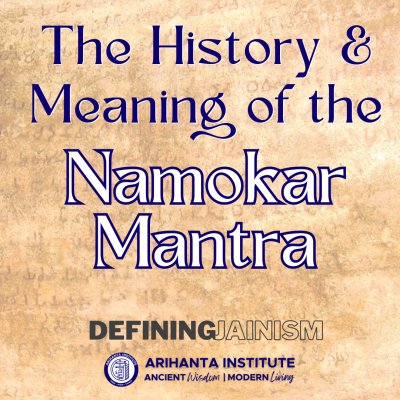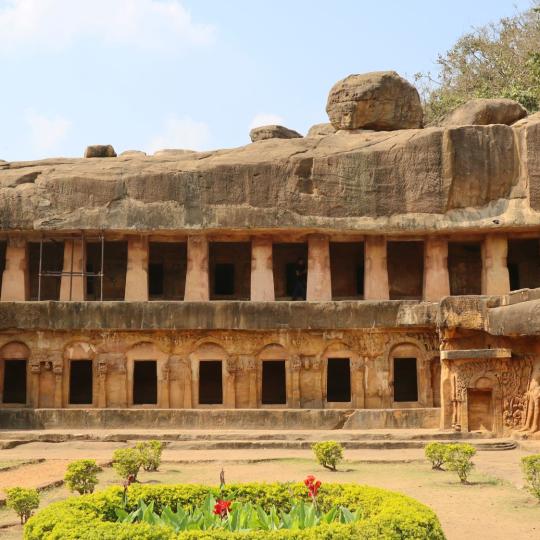
Two questions I often receive from students are: Where does the Namokar Mantra come from? What does it mean? If you also ask these questions, read on to find out more.
namo arihantāṇaṃ
I bow to the Arhats
namo siddhāṇaṃ
I bow to the Siddhas
namo āyariyāṇaṃ
I bow to the Ācāryas
namo uvajjhāyāṇaṃ
I bow to the Upādhyāyas
namo loe savva-sāhūṇaṃ
I bow to all the Sādhus in the world
eso paṃca-namokkāro
This five-fold recitation
savva-pāva-paṇāsaṇo
destroys all evil
maṅgalāṇaṃ ca savvesiṃ
and amidst all the auspicious recitations
paḍhamaṃ havai maṅgalam
it is the most auspicious
The Namokar Mantra (sometimes called “Navkar” mantra) is chanted daily – sometimes several times – by most all Jains around the world. I have even met some spiritual practitioners who were not born into the Jain tradition who chant it as well. This mantra bears great spiritual significance in the Jain tradition and is thus worthy of our historical attention.
According to many Jains, the Namokar Mantra (Prakrit: paṃca-namokkāra) has always existed and was not created. According to available historical evidence, its origins are from India in the 1st century BCE. Since then, the Namokar Mantra has evolved and changed into its current form quoted above.
In 1986, scholar Gustav Roth published a fascinating historical account of the Namokar Mantra and its meanings, some highlights of which I share with you here. [1] Following Roth’s article in the first section, we answer the question, “Where does the Namokar Mantra come from?” And in the second section, “What does it mean?”
A Brief History of the Namokar Mantra
As Roth pointed out, the first material evidence of the Namokar Mantra is found in the Prakrit cave inscription of Khāravela near Bhubaneshwar, Orissa. This inscription, which is from around the 1st century BCE, reads as follows:
namo arahaṃtānam | namo sava-siddhānaṃ ||
“I bow to the arhats, I bow to all siddhas”
For those who chant the Namokar Mantra every day, you will notice two things about this inscription. First, the spelling of arahaṃtānam and the compound sava-siddhānaṃ are slightly different from what you are likely accustomed to chanting: arihantāṇaṃ and siddhāṇaṃ.
Second, this earliest inscriptional version is also much shorter than the mantra you are accustomed to chanting, the first part of which is probably closer to something like this and pays respect to the five supreme beings (pañca-parameṣṭhin):
namo arihantāṇaṃ
namo siddhāṇaṃ
namo āiriyāṇaṃ
namo uvajjhāyāṇaṃ
namo loe savva-sāhūṇaṃ
This familiar version is in fact the earliest textual reference of the Namokar Mantra from the 2nd century CE ascribed by Vīrasena to Puṣpadanta’s first verse in his Digambara scripture titled Ṣaṭ-khaṇḍāgama. Everything here matches what you are likely accustomed to chanting, though you will note the tiny difference in the spelling of “āyariyāṇaṃ”, here in Puṣpadanta’s version spelled “āiriyāṇaṃ.” If this is the earliest identifiable Digambara version of Namokar Mantra, where is the Śvetāmbara version?

In the 3rd century CE in a non-canonical Śvetāmbara text titled Vasudevahiṇḍi written by the author Saṅghadāsa, to be exact. After paying tribute to the Jain tradition, those who have overcome their passions, and Ṛsabha (the first Jina), we find salutations then given to the five supreme beings, with commentary between where you see ellipses here (I will return to this):
namo… arahantāṇam
namo… siddhāṇam
namo… āyariyāṇaṃ
namo… uvajhhayāṇaṃ
namo… sāhūṇam
As you will notice here, the spelling “arahantāṇam” comes closer to the inscriptional spelling at Khāravela, which you recall was “arahaṃtānam”, but also differs from Puṣpadanta’s “arihantāṇaṃ”. The spelling of “āyariyāṇaṃ” here also differs from Puṣpadanta’s “āiriyāṇaṃ”.
These are minor differences for sure, but for those who emphasize pride of purity and tradition, these small changes of pronunciation make the mantra sound slightly different, and thus raise the question regarding how important it really is in Jain tradition to chant the Namokar Mantra in a particular way.
What is more interesting about both Puṣpadanta’s Digambar version and Saṅghadāsa’s Śvetāmbara versions, however, is the fact that both still leave out the second part of the Namokar Mantra that is chanted today. We will not find that second part appended to the mantra until much later in the 7th century CE canonical Śvetāmbara text titled Mahānisīha-sutta, which reads as follows:
namo arahantāṇaṃ…
namo siddhāṇaṃ…
namo āyariyāṇaṃ…
namo uvajjhāyāṇaṃ…
namo loe savva-sāhūṇaṃ…
eso paṃca-namokkāro
savva-pāva-paṇāsaṇo
maṅgalāṇaṃ ca savvesiṃ
paḍhamaṃ havai maṅgalam
This first part of the Namokar Mantra here follows the spellings of the salutations to the five supreme beings exactly as we already found them in the Vasudevahiṇḍi above, except that after each of the salutations in the Mahānisīha-sutta, there are verses following the ellipses above that include ritual instructions regarding how to pay tribute to each parameṣṭhin. That is to say, although it appears to match the form of the Namokar Mantra chanted today, there are in fact breaks between each of the five supreme beings that make chanting their names sequentially impossible.
So where does the exact version of the Namokar Mantra that we chant everyday come from? Some Jains will tell you it is timeless and eternal, some will say it is part of an unwritten oral tradition, and some scholars will tell you to keep trying to find out. What is perhaps even more fascinating, however, is what this mantra is understood to mean.
Meaning of the Namokar Mantra
Ask a Jain what the meaning of the Namokar Mantra is, and you will hear a number of similar and yet different responses. Indeed, like the history of the mantra itself, there are several overlapping and sometimes divergent interpretations of its meaning and purpose. Let us compare several interpretations here drawing once again from Gustav Roth’s research on this topic, which looks at what are fairly late commentaries that begin to interpret the mantra.
Recall the ellipses in Saṅghadāsa Gaṇin's non-canonical Vasudevahiṇḍi (3rd century CE) cited above. There we find the following explanations for each of the five supreme beings:
namo… arahantāṇam (I bow to the Arhats)
“whose lotus-like feet have been worshipped by Gods with courtesy and reverence.”
namo… siddhāṇam (I bow to the Siddhas)
“who are flourishing through perfectly purified Cognition and Seeing”
namo… āyariyāṇaṃ (I bow to the Ācāryas)
“who are experts in the rules of religious practices expounded by the Jina-s”
namo… uvajhhayāṇaṃ (I bow to the Upādhyāyas)
“who are instructors of the highest accomplishment of the Holy Tradition to their pupils.”
namo… sāhūṇam (I bow to the Sādhus)
“who are effecting the performance which is the cause of moving towards the abode of complete attainment of Salvation.” [2]
These short salutations in the Vasudevahiṇḍi thus reflect many of the basic explanations of the Namokar Mantra provided by Jains today. To summarize from the top down:
- The Arhats are those who (having attained omniscience while living) remain embodied to share the teachings of the Jain tradition and “whose lotus-like feet” are thus “worshipped by the Gods”;
- The Siddhas are those souls who, having eliminated all of their karma, dispassionately observe the universe from above;
- The Ācāryas are reliable leaders of ascetic groups and serve as the highest models of proper ascetic behavior;
- The Upādhyāyas are those responsible for teaching Jain knowledge to their ascetic students;
- The Sādhus past and present are those typically tasked with embodying the proper conduct for eliminating karma.
It is quite interesting that a non-canonical Śvetāmbara text from the 3rd century CE contains explanations that reflect a commonly-held basic interpretation of the five supreme beings amongst contemporary Jains today.
Later, in the 7th century CE canonical Śvetāmbara text Mahānisīha-sutta which we have already encountered, we find much elaboration on the meaning of each of the five supreme beings. Gustav Roth details the explanations of just the first, the “arahant”, noting how the text acknowledges that the omniscient and yet embodied-in-the-world arahant, having completely destroyed their “invincible enemy” – the eight karmas – will not be born again and therefore deserves “supreme excellence” through “an excess of homages (pūjātiśaya)”. [3]
In Vīrasena’s early 9th century CE Dhvalā ṭīkā commentary on the Digambara Ṣaṭ-khaṇḍāgama (2nd century CE), the scripture which we already encountered above as the first textual instance of the Namokar Mantra, we find further elaborate explanations of “arihant” (rather than Mahānisīha-sutta’s “arahant”). Interestingly, while Vīrasena agrees that the arihant deserves “worship of the highest order”, he ascribes this status to them due to their five auspicious life events (pan̄ca-kalyāṇaka) and eventual attainment of mokṣa, in other words, for “descending from heaven, birth, anointing, going forth completely, rising of kevala-jñāna, and their Parinirvāṇa.” [4]
Furthermore, according to Vīrasena, one can also be an arihant not due to their elimination of eight karmas as explained by the Mahānisīha-sutta, but rather on account of their elimination of either “mohaṇijia kamma” (“Confusing” karma) or; nāṇāvaraṇijjaṃ (“Cognition” karma) and darisaṇāvaraṇijjam (“Seeing” karma) or; antarāiyam (“Obstructing” karma). [5] These four karmas correspond to the fourth; first and second; and eighth karmas in the Paṇṇavaṇā-sutta, respectively, and apparently only one of them needs to be eliminated in order for someone to be considered an arihant. The critical particle here in the original text is “vā”, which means “or” and indicates that any of these possibilities by Vīrasena permit someone to be counted as an arihant.
One last interesting note on the meaning and purpose of the Namokar Mantra comes from Devendra's ṭīkā on the Uttarādhyayana-sūtra from the 12th century CE. In a story here, we find Paumāvaī Devī who is lost in the forest and eventually remembers the Namokar Mantra (here navakāra) and praises the mantra for its ability to bring her happiness and to protect her against dangers and evils. These include “the dangers of disease, flood, fire, thieves, of the fight with lions and elephants, and of snakes… from female goblins, vampires, bears and murderers.” [6] Furthermore, Paumāvaī Devī explains how the mantra, when kept close to one’s heart cavity (hiyaya-guhāe) creates conditions wherein “the eight knots of Karma has completely vanished.” [7] In other words, the mantra also destroys all eight of the Jain tradition’s karmas.
Here, the Namokar Mantra is a purveyor of happiness, a protective device, as well as a spiritually beneficial, karma-eliminating sound. These 12th century interpretations come quite close to many popular Jain understandings of the mantra’s overall functions and capabilities today.
Conclusions
Compare these sometimes differing explanations of the Namokar Mantra from Jain scriptures with JAINA’s public interpretation of the five supreme beings or Acharya Sushil Kumar’s embodied understanding, for example, and appreciate the continuities and discontinuities between the past and present as the Namokar Mantra continues to evolve to sonically express the devotion, beliefs, hopes, and spiritual aspirations of the global Jain community.
Over thousands of years, the Namokar Mantra, along with its meaning and functions, have certainly transformed and changed. Nevertheless, the mantra’s core meaning as a salutation to those striving for the elimination of karma and liberation, that is, the arhats and siddhas whose names we find inscribed in the 1st century BCE in the Khāravela caves, remains.
***
This article is just the begining of scholastic exploration into the Jain tradition past, present, and future. If this type of content and research interests you, apply to our MA – Engaged Jain Studies program where we explore the many fascinating historical, philosophical, and anthropological dimensions of the Jain tradition and how they apply to contemporary society.
[1] See: Roth, Gustav. 1986. “Notes on the Paṃca-Namokkāra-Parama-Maṅgala in Jain Literature.” In Heinz Bechert and Petra Kieffer-Pülz (eds.), Indian Studies (Selected Papers). Delhi: Sri Satguru Publications. pgs.129-146.
[2] Translations quoted directly from Roth, 1986, “Notes on the Paṃca-Namokkāra-Parama-Maṅgala”, 137.
[3] Roth, 1986, “Notes on the Paṃca-Namokkāra-Parama-Maṅgala”, 142-143. Roth is borrowing here from Deleu.
[4] Ibid., 142. Translations quoted directly from Roth.
[5] Ibid., 140-141. Translations quoted directly from Roth.
[6] Ibid., 134. Translations quoted directly from Roth.
[7] Ibid., 134-135. Translations quoted directly from Roth.
Note: This article was originally published on 06/14/2023.

